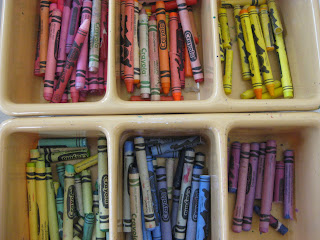Day 1: What is sculpture? Where is Oaxaca? Show student PowerPoint (includes map of Mexico, copal tree, artists at work, examples, close up of details). Explain how this craft supports the artist financially. Demonstrate how to use random wood pieces to create an animal with dimension/form. Demonstrate the best use of the hot glue gun (I show them how to use a Popsicle stick to push things together and avoid touching the hot glue).
Day 2/3: Finish building. Demonstrate how to paint the base layer one or two solid colors with acyclic paint. Tempera can be used, as it tends to be more colorful, but causes problems when painting additional layers on top for the next step. What is pattern? While waiting, students can brainstorm ideas for the intricate patterns they will add using paint or markers.
Materials:
PowerPoint with visuals of sculptures, artists, map of Mexico
Google Earth
Boxes of wood scraps
Clear Plastic Bins to put wood in (more visible)
Hot Glue Guns
Glue sticks
Popsicle sticks
Acrylic Paint
Markers for pattern and details
Examples of pattern and lines
Vocabulary:
Sculpture
Dimension/Form
Pattern
Line

Thursday, February 3, 2011
Tuesday, February 1, 2011
8th Grade: Contour Line Drawings of Hands with Watercolor Background
Day 1: (50-70 min) What is a contour line? Demonstrate several warm-up activities, including drawing the creases of the palm of your hand and a blind contour line drawing of a hand gesture, stressing the importance of looking at what you are drawing. Discuss the Right Brain vs. Left Brain. Students should complete one drawing of a gesture that they are pleased with on newsprint. This gesture will be traced three times on 12 x 18 90lb white drawing paper with Sharpie marker. Cut hands out.
Day 2: (50-70 min) What are warm colors? Cool colors? Have students create a design of various shapes on watercolor paper with stencils. Students will decide if they want warm colored shapes, or cool ones. Shapes will be outlined with warm or cool colored crayons as this helps to contain watercolors when painting. What is a watercolor wash? Demonstrate the 10 watercolor washes listed below. Have students practice on 3 x 12 inch strip of WC paper. For background, students must incorporate all ten WC washes. If the shapes are warm, background is cool and vice-versa. This helps prevent muddled colors.
Day 3: Finish painting and hands (if not done yet). Attach three cut out hands in an interesting way to the WC background with 3D-O's
Watercolor Washes:
Wet-on Wet Even
Glazing Gradual
Blotting Resist
Salt Splatter
Blow Dry Brush
Vocabulary:
Contour Line
Negative Space
Observational Drawing
Watercolor wash
Warm and Cool colors
Materials for Hands:
Drawing boards
Sharpies
Newsprint
12 x 18 drawing paper
Light table
3D-O's
Materials for Watercolor Background:
Stencils
Crayons
Dr. Martin's Watercolors
Palettes
Brushes
Water Containers
Paper towels
Kosher Salt
3 x 12 strip of watercolor paper
12 x 18 watercolor paper
6th Grade: Jumbeled Names
Great project to learn 6th grade names and personalities in September!
Day 1: (50 minutes) Demonstrate on the board how to draw large block letters that stretch across the entire page. I show them how to make stick letters, and then drive around the outside of the letter like a car, and erase the inside. Students may need to experiment with size and lay out in sketchbooks. Use this layout: First letter must touch bottom and left side of paper. Second letter should touch the first letter and the top of the page. Third letter should touch the second letter and the bottom of the page, etc.
What is negative space? Pattern? Line? Symbols? Students will fill the negative space between his/her letters with all three. Students will brainstorm ideas in his/her sketchbooks for symbols that represent personal interests or traits.
Day 2/3: (70 minutes) Students will create his/her name design on 12 x 18 drawing paper. Letters should be left white or colored black. Stress the importance of DENSE pattern, symbols, and lines in the negative space. The negative space could be black or colored using markers. The name should jump off the page because of the dense negative space.
Materials:
Sketchbook
Pencils
Markers
12 x 18 60lb white drawing paper
Line and Pattern ideas sheet
Vocabulary:
Block Letters
Pattern
Line
Symbol
Negative Space
Day 1: (50 minutes) Demonstrate on the board how to draw large block letters that stretch across the entire page. I show them how to make stick letters, and then drive around the outside of the letter like a car, and erase the inside. Students may need to experiment with size and lay out in sketchbooks. Use this layout: First letter must touch bottom and left side of paper. Second letter should touch the first letter and the top of the page. Third letter should touch the second letter and the bottom of the page, etc.
What is negative space? Pattern? Line? Symbols? Students will fill the negative space between his/her letters with all three. Students will brainstorm ideas in his/her sketchbooks for symbols that represent personal interests or traits.
Day 2/3: (70 minutes) Students will create his/her name design on 12 x 18 drawing paper. Letters should be left white or colored black. Stress the importance of DENSE pattern, symbols, and lines in the negative space. The negative space could be black or colored using markers. The name should jump off the page because of the dense negative space.
Materials:
Sketchbook
Pencils
Markers
12 x 18 60lb white drawing paper
Line and Pattern ideas sheet
Vocabulary:
Block Letters
Pattern
Line
Symbol
Negative Space
Subscribe to:
Comments (Atom)
















